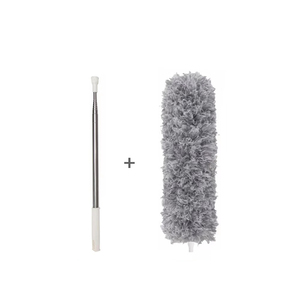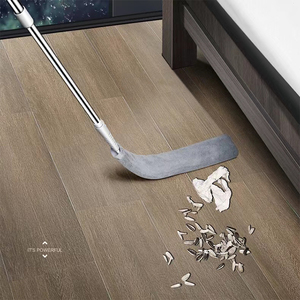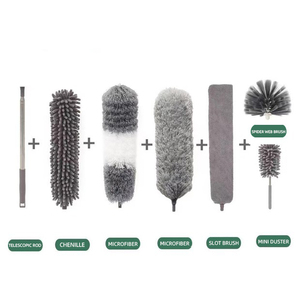
All categories
Featured selections
Trade Assurance
Buyer Central
Help Center
Get the app
Become a supplier

(1212 products available)



































Indian brooms, also known as "jharus," are traditional cleaning tools used across the Indian subcontinent. They are made from a variety of natural materials, with different designs and functions. These are some commonly used types of indian broom stick:
Made from the flower heads of the coconut palm, phool jhadu is soft and flexible, making it suitable for sweeping fine dirt and dust on smooth surfaces like floors. The soft texture of the coconut fibers prevents scratching or damaging the surface being cleaned, which is why phool jhadu is commonly used in households to keep floors clean without causing any wear.
Chowk brooms are typically made from a combination of grasses and sticks, which give them a stiffer texture and make them more suitable for outdoor use or sweeping rough surfaces. They are larger and more robust than phool jhadu, making them ideal for tasks like sweeping yards, driveways, or streets. Chowk brooms can effectively remove debris and mud from outdoor areas, making them a practical and durable cleaning tool for both homes and public spaces.
Khurpa brooms are a type of jharu that is made by tying together the leaves of the date palm. The resulting broom is firm and durable, making it well-suited for heavy-duty cleaning tasks. Khurpa brooms can tackle large areas and stubborn debris, thanks to their sturdy construction. They are commonly used in commercial spaces, workshops, and construction sites, where effective cleaning is required to maintain a safe and orderly environment. Khurpa brooms can withstand the rigors of frequent use and provide reliable performance over time.
Sikki jhadu is crafted from the stems of a special grass called sikki. These brooms have a fine texture and are known for their intricate weaving. Sikki jhadu is commonly used for decorative and ceremonial purposes, such as in weddings and religious rituals. They can also be used in homes to clean small areas, such as tabletops or corners. Sikki jhadu is valued for its craftsmanship and versatility, making it a traditional yet practical cleaning tool in Indian culture.
Paish brooms are made from a combination of date palm leaves and bamboo sticks. They are known for being large, sturdy, and durable. Paish brooms are ideal for heavy-duty cleaning tasks, such as sweeping large open areas or removing debris. They are commonly used in commercial and outdoor settings, such as markets, streets, and construction sites. Paish brooms can cover a wide area quickly and effectively, thanks to their size and stiffness. They are a practical and reliable tool for keeping spaces clean in a variety of environments.
The design of indian style broom is a crucial factor in their functionality. Different broom designs are suited to different types of cleaning tasks and floor surfaces. Some of the common designs of Indian brooms are:
These are the most commonly used Indian brooms, known for their simplicity. They consist of a bundle of stiff natural fibers tied to a stick handle. The stick serves as a lever for sweeping, and the bristles make contact with the surface to be cleaned. The standard stick broom design is effective for a wide range of surfaces, from smooth floors to rough outdoor areas.
These brooms are made of corn husks or a similar plant material. The corn husks are tied to a stick handle, creating a large, round head for sweeping. Corn brooms are particularly effective at sweeping up larger debris or on rough surfaces. The natural materials used in the construction of corn brooms provide stiffness and durability, making them well-suited for heavy-duty cleaning tasks.
These brooms are made from coconut palm leaves. They are tightly bound together and attached to a wooden or bamboo stick. The coconut palm leaves are stiff, making this broom effective for outdoor and heavy-duty cleaning. They are commonly used in yards, gardens, or construction sites to sweep up leaves, dirt, and other debris. The sturdiness and abrasiveness of the coconut palm leaves make this broom well-suited for rough surfaces.
Grass brooms are made from soft grasses such as rice straw and wheat. They are commonly used for indoor household cleaning. The softness of the grass makes them suitable for use on wooden and tile floors, as it will not scratch or damage the surface. Grass brooms are also lightweight, making them easy to use for extended periods.
The bamboo broom is made from bamboo and is known for its sturdiness and durability. The bamboo sticks are often used for the handle and the bristles, providing a lightweight option for heavy-duty cleaning tasks. Some bamboo brooms have their bristles made from other materials. Various designs of Indian brooms offer versatility, allowing the users to choose a broom that will effectively cater to their cleaning needs.
Desi broom are used extensively for home cleaning. They are used to sweep floors, patios, and other areas. Jharoos are used to remove dust, dirt, and leaves. They are also used to clean corners and under furniture. Brooms are used daily to keep homes neat and clean.
Indian brooms are used for religious and ritual purposes. They are used to prepare and clean areas for worship. Brooms are used to clean temples, prayer rooms, and other sacred spaces. They are used to remove old flowers, leaves, and other offerings. Brooms are important for maintaining the cleanliness and sanctity of religious places.
Indian brooms are also used in arts and crafts. The dried twigs and stems of the brooms are used to make decorative items. They are used to make wall hangings, baskets, and other items. Indian brooms are a valuable material for traditional artisans.
Indian brooms are used for street cleaning and municipal purposes. Municipal workers use brooms to clean streets, markets, and public spaces. The brooms are effective for sweeping away dust, trash, and debris. They help maintain the cleanliness of public areas.
Indian brooms are used in many commercial establishments. They are used in offices, shops, and restaurants. The brooms are used to maintain the cleanliness of the premises. They are used to sweep floors and other areas with heavy foot traffic. Brooms are an essential tool for commercial cleaning.
Indian brooms are used in farms and gardens. They are used to sweep dry leaves, hay, and other plant material. Farmers use the brooms to clean floors and storage areas. They are an essential tool for maintaining farm hygiene. Some farmers also use the brooms to make compost piles. The brooms help composting by aerating the materials.
Indian brooms are used in craft brewing and distilling. Brewers and distillers use the brooms to clean equipment and work areas. The brooms are effective for sweeping away spent grains, hops, and other brewing ingredients. They help keep the brewing process clean and hygienic.
Choosing the right Indian broom is a matter of personal preference and the specific cleaning needs of the household. Some of the key points to consider when choosing an Indian broom are:
Q1: What are the advantages of using Indian brooms compared to conventional brooms?
A1: Indian brooms are more efficient in cleaning larger floor areas. They are also more durable and eco-friendly.
Q2: Do all Indian brooms have a specific design?
A2: Indian brooms are made in various designs to meet specific cleaning needs. The jharu broom is, however, the most common.
Q3: Are Indian brooms meant for any specific type of floor?
A3: Indian brooms can be used on any type of floor, including tiles, wooden surfaces, and concrete.
Q4: Do Indian brooms have handles?
A4: Most Indian brooms are made with handles for easy use. The handles can be made from materials such as wood and metal.
Q5: Are there specific storage instructions for Indian brooms?
A5: Indian brooms should be stored in dry places and hung upright when not in use to prevent them from getting damaged.